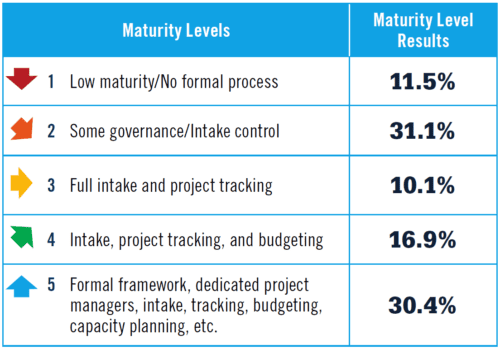Low Project Management Maturity Is Costing Your Company

Companies and organizations, no matter how big or small, can vary in project management and IT management maturity. Even large, well-established companies can find themselves suffering from immature processes and workflows. In fact, a recent market study by ProjectManagement.com found that 42.6 percent of companies surveyed were worried that their organizations were operating at a low maturity level. The study asked participants to use a scale of 1-5 to rank their perceived maturity level.
The levels are as follows:
- Level 1 – Low maturity with no formal process
- Level 2 – Some governance/intake control
- Level 3 – Full intake and project tracking
- Level 4 – Intake, project tracking and budgeting
- Level 5 – Formal framework, dedicated project managers, intake, tracking, budgeting, capacity planning, etc.
If you had to rank your business or organization today, where would you fall?
Impact of immaturity on business
Organizations on the top end of the scale – those ranking themselves 4s or 5s – are likely consistent when it comes to delivering projects successfully. While those ranking themselves on the lower end of the scale – the 1s and 2s – are probably struggling to deliver projects both on time and within scope. When asked what percentage of projects achieved business goals, organizations that ranked themselves at levels 1 and 2 on the maturity scale were six-and-a-half times more likely (14.3%) to have more than half of their projects fail versus a mere 2.2% of level 5 organizations. Those failed projects add up.

Impact of immaturity on budgets
It’s no surprise that organizations at level 1 or level 2 also say they struggle to keep projects on schedule and on budget. On average, those surveyed reported more success with keeping projects on a budget (52.7%) than on schedule (41.9%), but when looking at the high and low ends of the scale, level 5 organizations were at least twice as likely to achieve these project outcomes when compared to level 1 and 2 level organizations.
The data shows that project governance (or lack thereof) seems to be the main predictor of projects’ success or failure. In addition, areas with the widest gaps between the two ends of the scales were resource capacity planning, formal project intake/governance review, and the existence of a formal project management office (PMO). Not every organization needs to be a level 5 – in fact, the focus for most businesses and organizations with low maturity should be on improvement.
To learn more about the heavy cost of low project management maturity, check out the TeamDynamix whitepaper with ProjectManagement.com.
This post was originally published in December 2020 and has been updated with additional information.